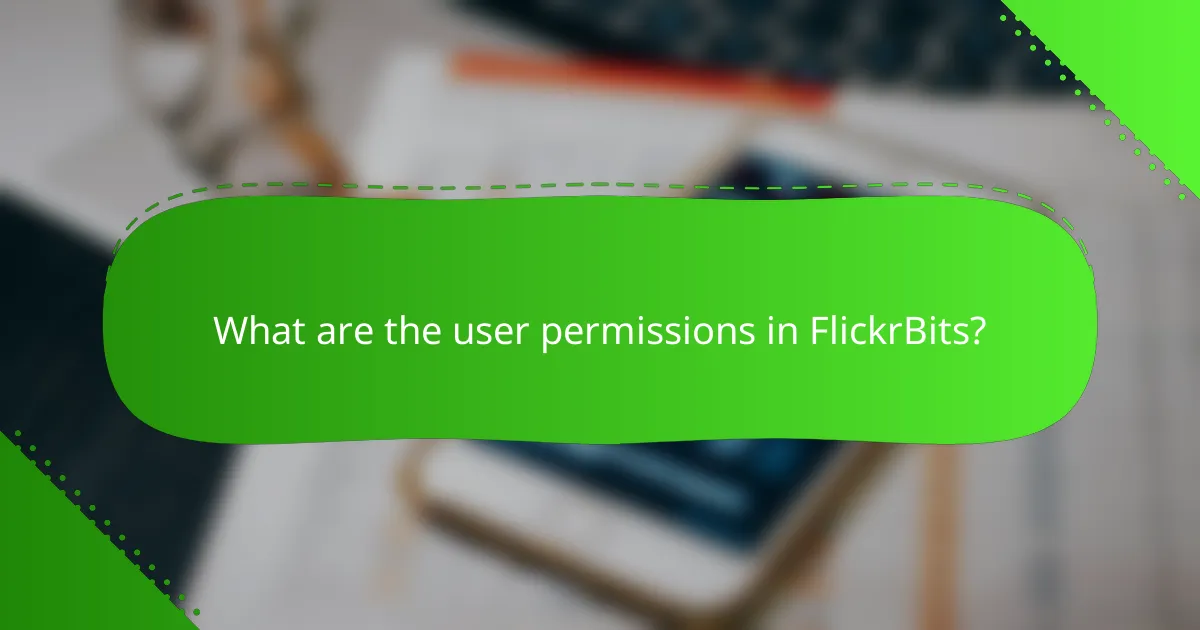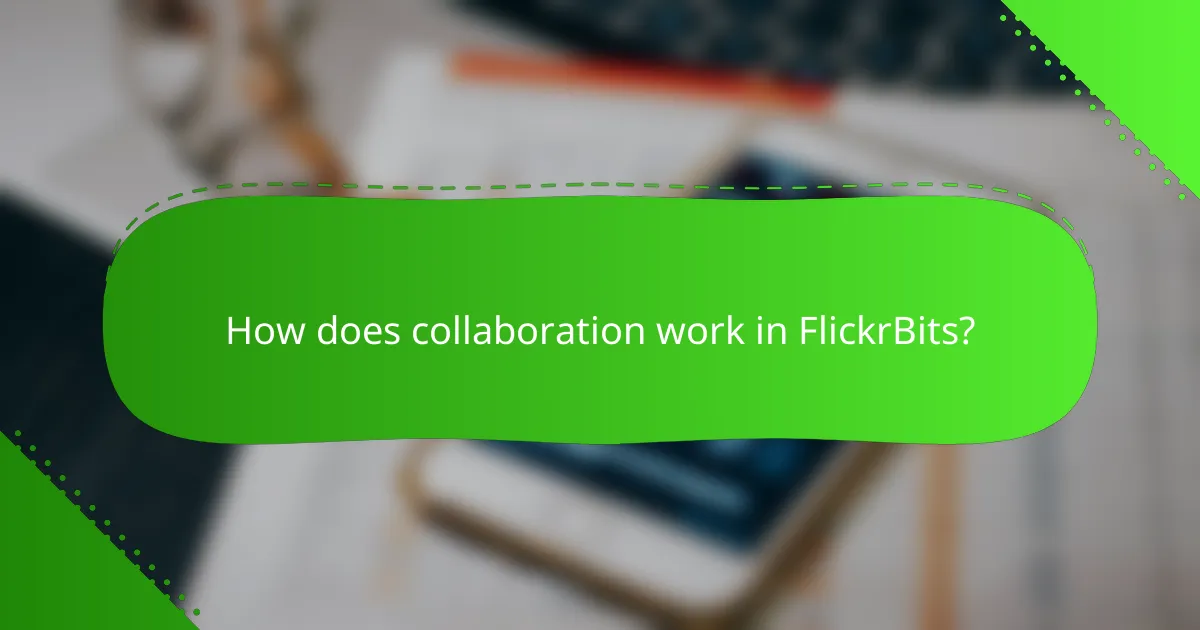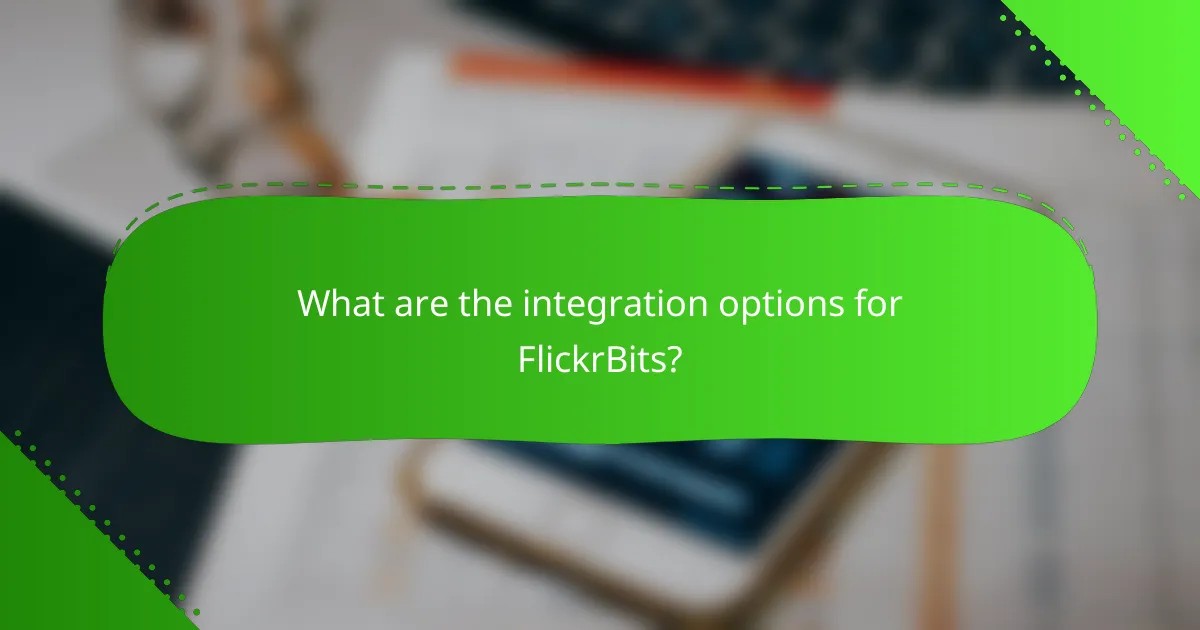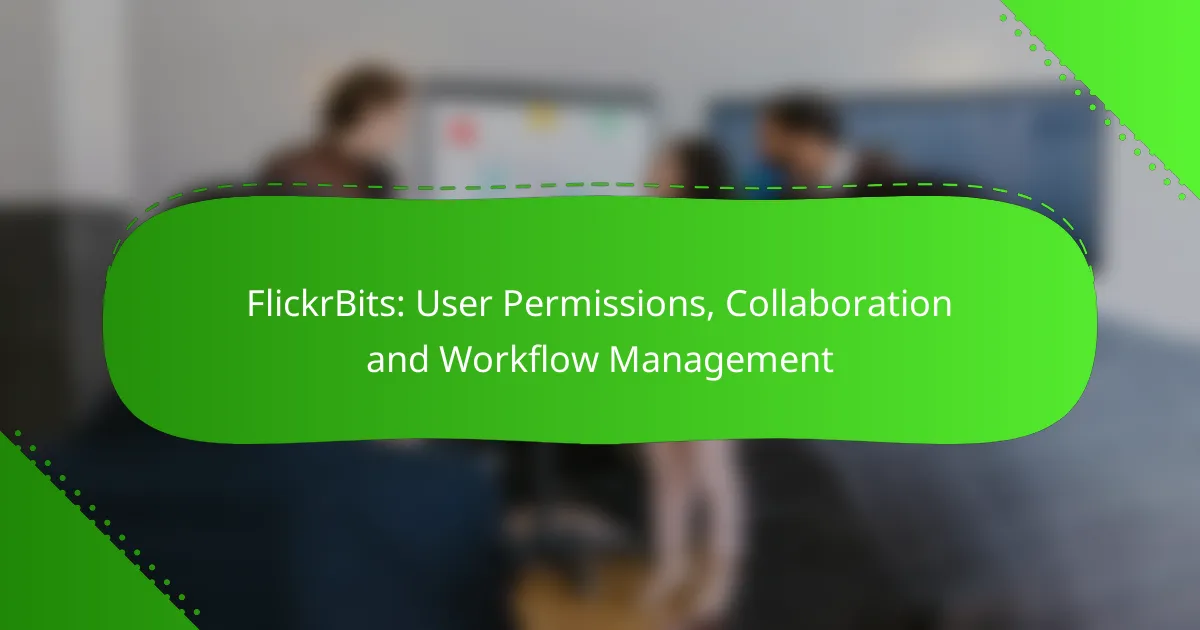FlickrBits provides a robust framework for user permissions, enabling effective control over content and collaboration features. By understanding these permissions, teams can manage workflows efficiently while ensuring security and content integrity. The platform enhances collaboration through real-time editing and sharing, allowing users to work together seamlessly on projects. Additionally, its workflow management tools streamline task assignments and progress tracking, fostering productivity and teamwork.

What are the user permissions in FlickrBits?
User permissions in FlickrBits define the level of access and control each user has over content and collaboration features. Understanding these permissions is crucial for effective workflow management and ensuring that users can contribute appropriately without compromising security or content integrity.
Admin permissions
Admin permissions grant users full control over the FlickrBits environment. This includes the ability to manage user accounts, set permissions, and delete or modify any content within the platform. Admins are responsible for overseeing collaboration and ensuring that workflows function smoothly.
Typically, only a few trusted individuals should hold admin permissions to minimize risks. It’s advisable to regularly review admin access to ensure that only necessary personnel maintain these privileges.
Editor permissions
Editor permissions allow users to create, modify, and delete content but do not include user management capabilities. Editors can collaborate on projects, upload images, and organize albums, making them essential for active content creation.
When assigning editor permissions, consider the user’s experience level and the sensitivity of the content they will handle. Providing training on best practices can help prevent accidental data loss or mismanagement.
Viewer permissions
Viewer permissions enable users to access and view content without the ability to make changes. This level is ideal for stakeholders or team members who need to review work without altering it, ensuring that the integrity of the original content is maintained.
It’s beneficial to use viewer permissions for external collaborators or clients who require insight into projects without the risk of unintended modifications. Regularly updating viewer lists can help maintain security and relevance in collaboration efforts.

How does collaboration work in FlickrBits?
Collaboration in FlickrBits allows multiple users to work together seamlessly on projects, enhancing creativity and efficiency. Users can edit, comment, and share content in real-time, making it easier to manage workflows and ensure everyone is on the same page.
Real-time editing
Real-time editing in FlickrBits enables users to make changes simultaneously, which fosters a dynamic collaborative environment. As one user edits a photo or project, others can see those changes instantly, reducing the likelihood of conflicting edits.
This feature is particularly useful for teams working on tight deadlines, as it allows for quick adjustments and immediate feedback. Users should ensure they have a stable internet connection to maximize the effectiveness of real-time collaboration.
Commenting features
The commenting features in FlickrBits facilitate clear communication among collaborators. Users can leave comments directly on images or projects, allowing for specific feedback and discussions about particular elements.
To make the most of this feature, users should be concise and constructive in their comments. Regularly checking and responding to comments helps maintain an active dialogue, ensuring that all team members are informed and engaged.
Sharing options
FlickrBits offers various sharing options to enhance collaboration. Users can share projects with specific team members or make them public for broader feedback, depending on the project’s needs.
When sharing, consider the level of access you grant. Options typically include view-only, comment, or edit permissions. It’s essential to choose the right level of access to protect your work while still encouraging collaboration.

What are the workflow management features in FlickrBits?
FlickrBits offers a range of workflow management features designed to streamline collaboration and enhance productivity. These tools facilitate task assignment, progress tracking, and integration with existing project management systems, making it easier for teams to work together efficiently.
Task assignment
Task assignment in FlickrBits allows users to delegate responsibilities clearly within a project. Team leaders can assign specific tasks to individuals or groups, ensuring everyone knows their roles and deadlines. This feature helps prevent overlap and confusion, making it easier to manage workloads effectively.
To maximize efficiency, consider using clear descriptions and deadlines when assigning tasks. This clarity helps team members prioritize their work and understand expectations, reducing the likelihood of missed deadlines.
Progress tracking
FlickrBits includes tools for progress tracking that enable teams to monitor the status of tasks in real-time. Users can view updates on completed, in-progress, and pending tasks, allowing for quick adjustments to project timelines as needed. This visibility fosters accountability and encourages timely completion of work.
Utilizing visual indicators, such as color-coded statuses or progress bars, can enhance understanding of project health at a glance. Regular check-ins can also help maintain momentum and address any roadblocks early on.
Integration with project management tools
FlickrBits seamlessly integrates with various project management tools, enhancing its workflow capabilities. This integration allows users to sync tasks, share updates, and communicate effectively across platforms, reducing the need to switch between applications.
When selecting project management tools to integrate, consider options that align with your team’s existing processes and preferences. Popular choices include Trello, Asana, and Jira, which can complement FlickrBits’ features and improve overall workflow efficiency.

What are the best practices for user permissions management?
Effective user permissions management is crucial for maintaining security and facilitating collaboration. Best practices include regular audits and implementing role-based access control to ensure users have appropriate access levels.
Regular audits
Conducting regular audits of user permissions helps identify and rectify any discrepancies in access levels. This process should occur at least quarterly, allowing organizations to adapt to changes in team structure or project needs.
During audits, review user roles and permissions against current project requirements. Remove access for users who no longer need it, and ensure that permissions align with their current responsibilities to minimize security risks.
Role-based access control
Role-based access control (RBAC) assigns permissions based on user roles within the organization, streamlining the management process. By defining roles clearly, organizations can ensure that users have access only to the resources necessary for their tasks.
Implementing RBAC involves creating a hierarchy of roles, such as admin, editor, and viewer, each with specific permissions. This approach reduces the likelihood of errors and simplifies onboarding new team members, as they can be assigned roles that automatically grant appropriate access.

How to optimize collaboration in FlickrBits?
To optimize collaboration in FlickrBits, establish clear communication and defined roles among team members. This ensures that everyone understands their responsibilities and can contribute effectively to the project.
Setting clear guidelines
Clear guidelines are essential for effective collaboration in FlickrBits. Establishing rules for how to share, edit, and comment on photos helps prevent confusion and miscommunication. Consider creating a document that outlines these guidelines and sharing it with all team members.
Include specifics such as deadlines for feedback and the format for submitting images. Regularly revisiting these guidelines can help keep the team aligned and focused on the project’s goals.
Utilizing tags and categories
Tags and categories are powerful tools for organizing content in FlickrBits. By using relevant tags, team members can easily find and group related images, which streamlines the workflow. Encourage everyone to use consistent tagging practices to enhance searchability.
Consider creating a standardized list of tags that reflect the project’s themes or topics. This not only aids in organization but also helps maintain a cohesive structure across the team’s contributions.

What are the integration options for FlickrBits?
FlickrBits offers several integration options that enhance user experience and streamline workflows. These integrations allow users to connect with popular collaboration tools and manage their photo-sharing processes more efficiently.
Integration with Slack
FlickrBits integrates seamlessly with Slack, enabling users to share photos and updates directly within their Slack channels. This integration fosters real-time communication and collaboration among team members, making it easier to discuss and manage visual content.
To set up the integration, users need to install the FlickrBits app from the Slack App Directory and authorize it to access their Flickr account. Once connected, users can share photos by simply using a command or uploading images directly into Slack.
Consider using Slack’s notification settings to ensure team members receive alerts when new photos are shared. This can help maintain engagement and keep everyone informed about the latest updates without overwhelming the channel with notifications.
